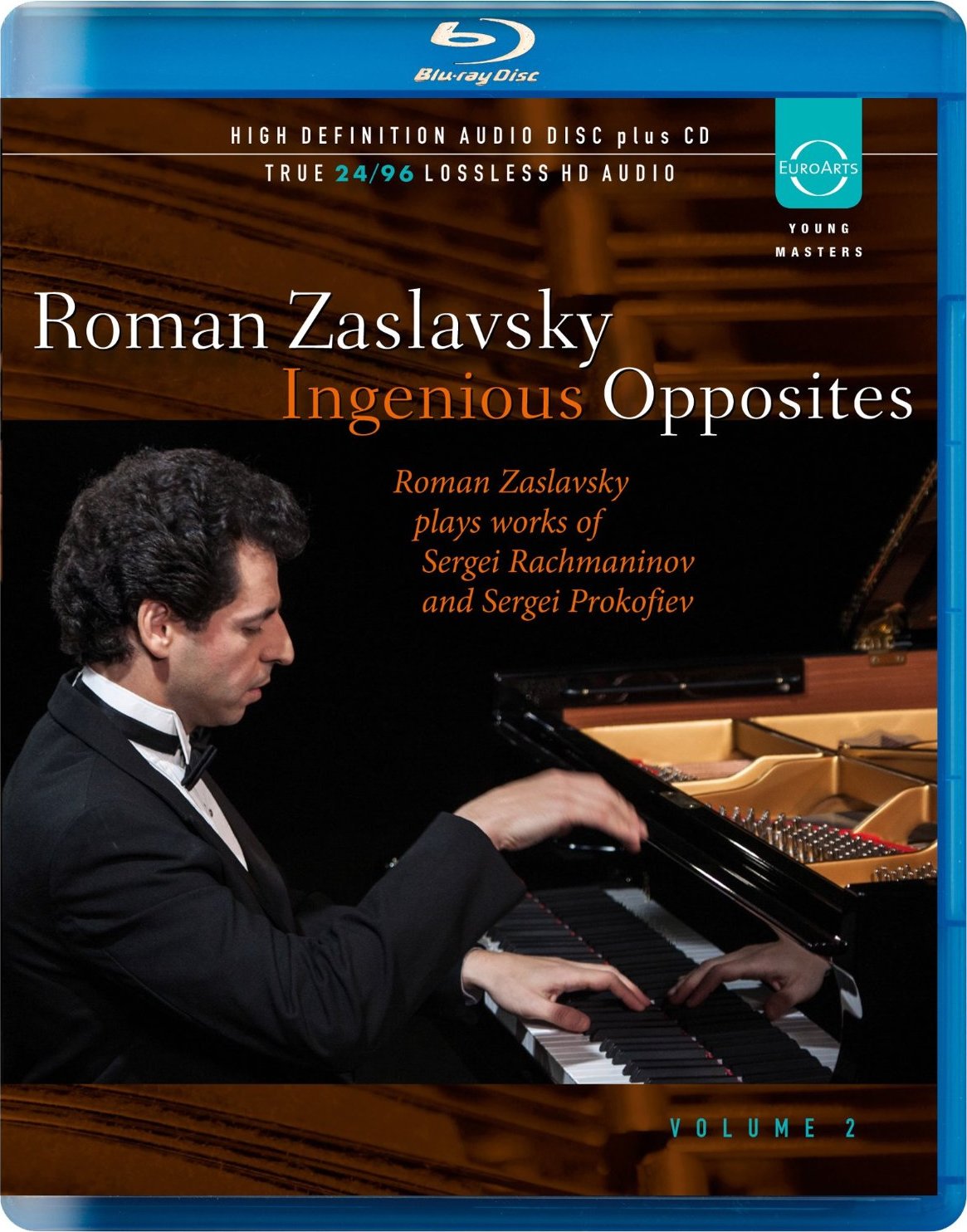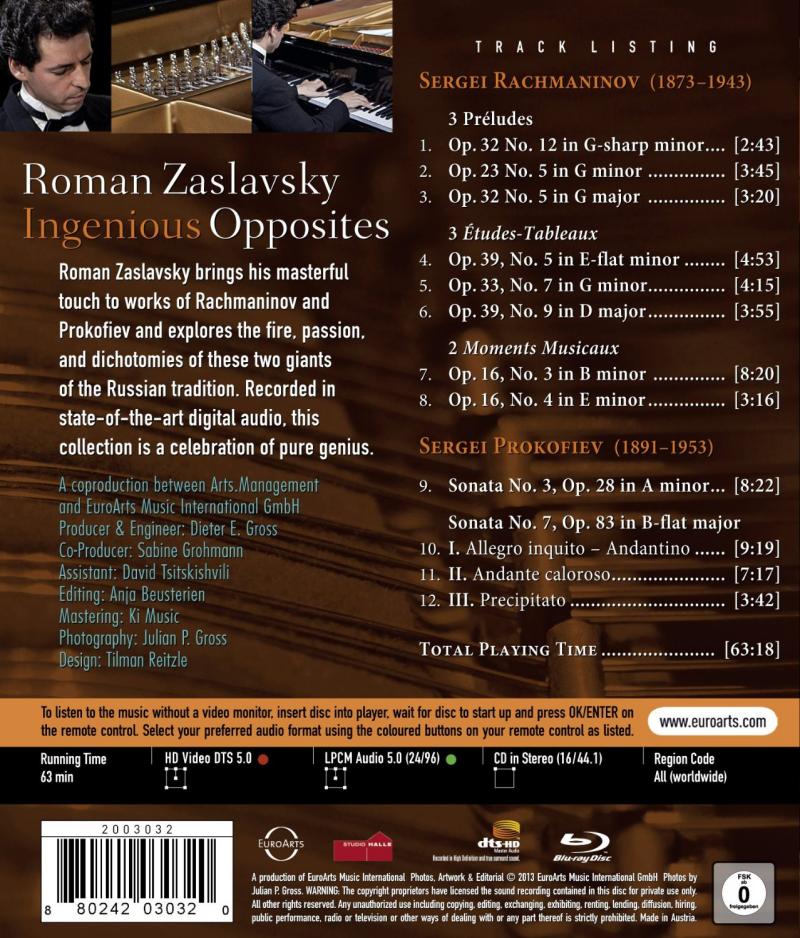

Roman Zaslavsky Ingenious Opposites piano recital (Volume 2). Zaslavsky plays the following pieces (twice):
Sergei Rachmaninov:
Prelude Op. 32: No. 12 in G sharp minor
Prelude Op. 23: No. 5 in G minor
Prelude Op. 32: No. 5 in G major
Etudes-tableaux Op. 39: No. 5 in E flat minor
Etudes-tableaux Op. 33: No. 7 in G minor
Etudes-tableaux Op. 39: No. 9 in D major
Moments musicaux Op. 16: No. 3 in B minor
Moments musicaux Op. 16: No. 4 in E minor
Sergei Prokofiev:
Sonata No. 3 in A minor, Op. 28
Sonata No. 7 in B flat major, Op. 83 (For this piece there are 3 tracks, one for each of the 3 movements)
Produced by Dieter E. Gross and Sabine Grohmann with assistant David Tsitskishvili; editing by Anja Beusterien; mastered by Ki Music; photography by Julian P. Gross; design by Tilman Reitzle. Run time for the 10 pieces performed on the disc is 63 minutes. No information is given with the product about the dates of the recordings. Released 2013, disc has 4.0 LPCM sound. Grade: D
Thanks to Wonk Jim Kreh for being the first to point out to me some of the mysteries surrounding the content of this title. The first and primary performance of the program is audio only with 96kHz/24-bit sound. The disc itself reports 96kHz sound and is silent as to word length. But the rear of the keepcase package gives the spec "24/96." This would seem to be similar to Vol. 1, which I understand was a Blu-ray audio disc only recorded at 96kHz/24-bit. The 1st page of the keepcase booklet has what appear to be track numbers for each selection (in little boxes on the left) running from 1 to 17. This is confusing, because the main program only has 12 tracks on the disc.
Then there is on the main menu a link to a "Bonus Video" in which Zaslavsky is seen performing the exact same program again in video:
For the video the disc reports 48kHz sound and is silent as to word length. But the rear of the keepcase package gives the spec "24/48." So it appears that with the video, you get the advantage of seeing the performance at the cost of normal rather than audiophile level sound.
The menu for the bonus video shows 12 tracks. But the video was made in two different shoots. The first shoot was Rachmaninov only with 8 tracks. The second shoot was the Prokofiev, which has 4 tracks—1 for Sonata No. 3 and 3 for Sonata No. 7 (one track for each of its 3 movements). To further confuse matters the track information on the disc itself speaks of 14 tracks.
The video is presented at "24.000" frames per second, a spec I've never seen or heard of before. We know that 35 mm motion picture film is shot at 24 fps. But the number you usually see on the Blu-ray discs is 23.976. The frame rate is slowed down a bit to better coordinate with the "pull down" process built into the Blu-ray home theater gear. The pull down allows the video to be displayed without motion artifacts at the TV rate of 30 fps.
If you set out to make an audiophile sound recording and a video, why wouldn't you do it all at one time? Why would anyone dream up and offer to the market the combination of performances described above? My guess is that the producers started out with audio-only in mind. But at the last minute they had opportunity to make a video in a different studio that did not have equipment to record the elite sound. But rather than speculate more about this, let's consider each of the performances more closely.
The audio performance. The best single thing about this title is the sound quality of the audio-only performance with 96kHz/24-bit sound. 4.0 surround is acceptable for the solo piano in recital. The sound is extremely clean and detailed, and it gives the impression of great accuracy in rendering the timbre of the different notes. They say that every Steinway has it's unique sound. With this recording I think I could detect the personality of the piano Zaslavsky was playing. It sounded even better than my current reference, the piano sound recorded in the AIX title Chamber Music Palisades. All of this irrelevant to us, of course, since this is a website about video rather than audio recordings. So let's go now to the bonus video, which is why we are here.
The video bonus. The sound at 48kHz/24-bit, although decent, is distinctly inferior to the audio-only version. PQ is pretty good with nice resolution and pleasant color balance. There are a few times when the video is out-of-focus, probably for a special effect. But most of the time the cameraman maintains a deep field of perfect focus so you can see the entire keyboard clearly. But alas, there are problems with video content. There are 2 or 3 camera on the right-hand (treble) side of the piano and no views from the left-hand (bass) side, which gets boring even with the short program. More surprising is the presence of irritating motion artifacts in the video. Even though Zaslavsky is a calm and undemonstrative person, there is noticeable motion judder often when he lowers his hands to the keyboard or moves his face and body quickly across the picture frame. I also see judder and blurring of the fingers in fast passages. It is unacceptable to have motion artifacts in a recording of a quiet person sitting in a chair. I suspect that the judder issue has something to do with the 24.000 fps rate.
Still, switching back and forth, I decided that I liked the defective video performance better than the state-of-the art audio-only recording! This confirms to me the theory of this website that seeing music performed is valuable even for something as simple as a piano recital. I don't use classical music for background noise. When I listen to classical music, I give it full attention. Seeing the pianist adds more to me than getting the very best sound. If you are interested in background music or you close your eyes when listening music, the audio-only part of the title might appeal to you.
Next we should consider the content of the program presented twice by Zaslavsky. It's short. Except for the Prokofiev Sonata No. 7, I would also consider this a lineup of relatively obscure pieces. Although their lives overlapped some, it's obvious that Rachmaninov was late romantic and Prokofiev was avant-garde modern. I don't see how blowing this up to the idea of "ingenious opposites" contributes anything. To me this is marketing hype designed to give a routine program an importance it doesn't have. Or maybe I’m all off base and the word “opposites” means something else than the different musical styles of the two famous Russian composers.
As to Zaslavsky's playing, I want to be cautious and fair. But when one is asked to pay regular price for a recording from Euroarts, one would normally expect to get an A-list or B-list established performer or something close to that. So I ask the question: "Who is Roman Zaslavsky?"
To his credit, Zaslavsky appears (here the video is a big help) to be a fastidious and earnest person who shows as much respect for his music and his audience as would be humanly possible. Still, Arkiv Music lists no recording from him for sale other than the two volumes of Ingenious Opposites. Wikipedia has a long list of recognized classical pianists, and Zaslavsky is not on it. From his own website, you can see he's made a living for many years playing recitals at minor venues and concerts with obscure orchestras.
In both recordings, I perceive pieces rather slowly and carefully played. For the most part, I find little to complain or to get excited about.
I do have to be critical, however, of Zaslavsky's performance of the Prokofiev Sonata No. 7. This is a giant of 20th century piano literature that has been taken up by many famous pianists. When I hear Zaslavsky do this, I don't feel the piece is being performed—rather I feel I'm at an autopsy where the piece is dissected. It seems to me that each note is carefully, reverently, snipped away from the corpse and laid out on an a marble slab for further inspection. I lose track of how the piece sounds as a whole. This is a very difficult work and Zaslavsky may be overreaching to program it.
It just so happens we already have a different performance of the Prokofiev Sonata No. 7 in the HDVD title Lang Lang in Vienna. Lang plays it so much faster than Zaslavsky that you would hardly think it's the same piece of music. Just for one small example, at 27:30 on the Zaslavsky Prokofiev video there is a particularly jarring pair of dissonant notes (repeated at 27:34) which is very noticeable at the slow Zaslavsky tempo. With Lang, the jarring notes are there of course, but they only seem to be a small part of the glitter of the Lang conception. In any event, Lang wipes out Zaslavsky in the Prokofiev Sonata No. 7. If you already have the Lang recording, you would get little new from subject title other than the Rachmaninov.
Sorry to be so long-winded. It's time to reach conclusions about and grade Ingenious Opposites, Vol. 2. This is a mostly small-ball program played cautiously in part and poorly in part. The sparking, elite audio-only sound is irrelevant except to infuriate us because it was not used for the video sessions. The video is blotched, and there is a much better recording of the Prokofiev Sonata No. 7 available on another popular HDVD. This leaves us with the grade of D, i.e., don't buy this unless you have a real good reason.
I feel sorry for Zaslavsky. This maybe could have been a breakthrough for him. But weird production decisions, slovenliness in disc authorship, judder in the video, and the too-slow Prokofiev Sonata No. 7 sink the project for me. Boy, it’s easy to criticize a recording that someone has worked on so hard! Figuring out what to say about this title has suggested to me how hard it must be to make a great recording. There are so many things that have to be properly coordinated by people who must really know what they are doing. We consumers need to be humble about it if we think we see or hear defects.
OR
